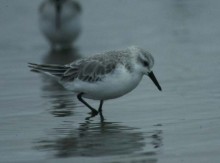Calidris alba
Subspecies
None.
Other Names
None
Identification
Small, pale wader usually seen on sandy beaches.
Plumage
Non-breeding: The head and upperparts are pale grey with darker grey mottling, though the forehead is white. The underparts are a pure white. The rump is white with a dark central line. The bill is short and black. The legs are black.
Breeding: The upperparts and breast are mottled dark reddish-brown.
Juvenile: the upperparts are dark grey with white notches and fringes to the feathers. The crown is dark grey with white streaks.
Distribution
Found most commonly in South Australia, but also is seen in the north west of Western Australia and the Northern Territory. It is found all around the Australian coast in lesser numbers. It inhabits the wash zone of sandy beaches running up and down with the waves.
Migratory habits
Sanderling arrive in Australia in September in the north of Western Australia and appear to migrate over the inland of Australia to South Australia. Other birds occur in small number on the east and west coasts. The birds leave Australia in April and seem to depart over Darwin rather than back over Western Australia.
Breeding
This species breeds in the high Arctic in Canada, Greenland, Spitzbergen and northern Siberia.
Status
The estimated population for the Sanderling is 8,000 birds.
East Asian-Australasian Flyway Population: about 22,000.
Confusing Species
Red-necked Stint: This bird is smaller than the Sanderling and more colour on the upperparts. It does not have the white forehead either.
Curlew Sandpiper: This bird is slightly larger with longer legs and a down-curved bill. In its breeding plumage there is no difficulty in identification.
Broad-billed Sandpiper: Although pale this bird has more markings and a double supercilium, plus has a slightly longer down-curved bill.

